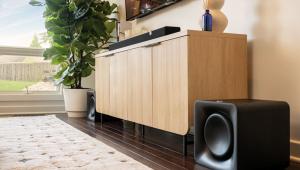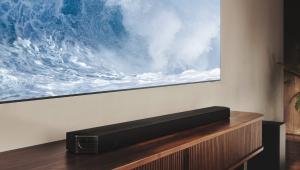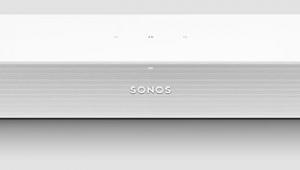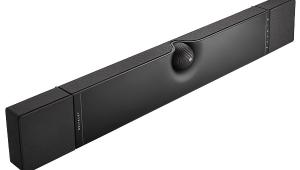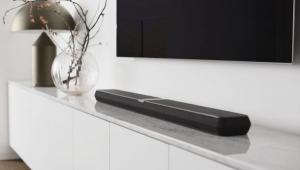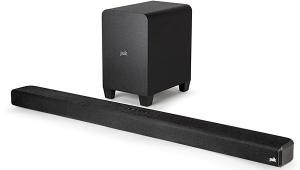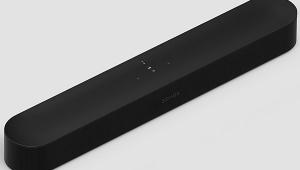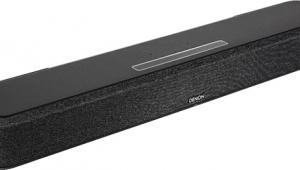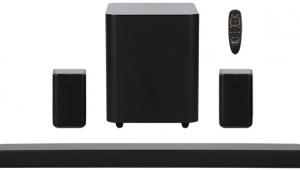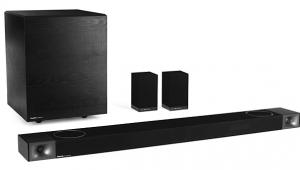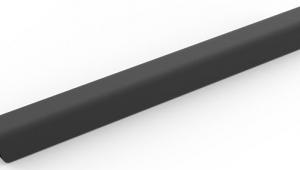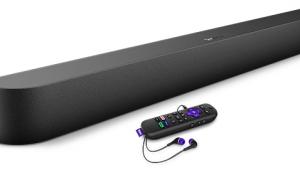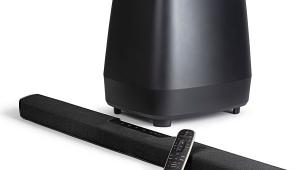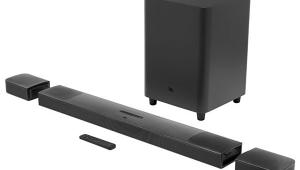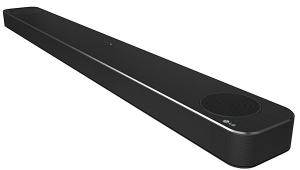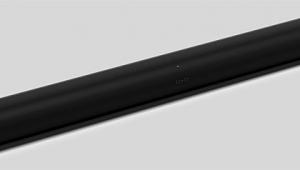The optional wireless surround speakers and subwoofer may be tempting but could significantly increase the overall cost. | drywall contractor
Sony HT-A5000 Soundbar Review
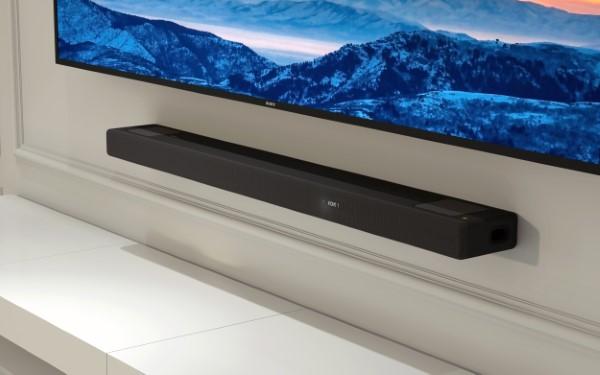
AT A GLANCE
Plus
Do-it-all abilities
Competent audio performance
Minus
Operational complexity
Intimidating manuals
THE VERDICT
The detailed setup and operation of the Sony HT-A5000 soundbar can be a little off-putting, but its performance doesn't disappoint and offers a dramatic upgrade over the on-board sound of virtually any television.
Description
At roughly 4 feet in width, the HT-A5000 contains six small loudspeakers (see Specifications): forward-facing left, center, and right, upward-firing left and right (assisted by a pair of tweeters), a small on-board subwoofer, plus the internal amps needed to drive them all. Sony also offers a pair of optional wireless surround speakers plus a separate subwoofer (also wireless). But those options will nearly double the price. This review covers only the HT-A5000 on its own, which can often be found on-line at considerable discounts from its $1,000 MSRP.
The HT-A5000 offers five physical connections located in a recessed rear panel: Toslink optical, HDMI In, HDMI Out, USB, and S-Center. The detachable power connection is located on the soundbar's rear at the far right.
The S-Center output offers the option to link the soundbar to a compatible port on your TV, allowing the latter's own speakers to join in the center of the party. To our knowledge, however, the corresponding S-Center input is only available on newer Sony TVs and not on older Sonys nor on any another TV brand, new or old. We did review such a Sony TV recently, but it had to go back before there was time to use it in this review. The television used here was the TCL 85QM8 we reviewed recently. It doesn't t offer an S-Center input so that feature was not tested here.

For the HT-A5000 to be fully functional one of your TV's HDMI inputs must be either eARC (enhanced Audio Return Channel) or ARC-capable. ARC is similar to eARC but without the latter's enhancements. ARC is available on some older sets and usable here as well, though with some limitations. If your TV has neither ARC nor eARC I don't recommend the HT-A5000 (or for that matter most other advanced soundbars).
The HT-A5000 also comes with its own remote control, which is important for the soundbar's setup and operation. It offers two optional, fixed response settings (Voice and Night, neither of which I recommend), adjustment for rear channel level (functional only if you've added Sony's optional wireless surrounds), a level control (which overlaps somewhat awkwardly with the TV's level control), and a three position subwoofer level adjustment that can control both the soundbar's built-in subwoofer and also Sony's optional wireless subwoofer (if used). A Sound Field button on the remote also offers a choice between three different fixed audio options: DSEE Extreme, Audio DRC, and Advanced Audio Volume, none of which I spent much time with. The HT-A5000 offers no user- adjustable graphic equalization.
 Once the TV and the soundbar are physically connected the remote control's Home button can call up a range of options on your TV screen inviting you select the source you want to watch or listen to. For audio-video sources (audio combined with video and not just audio) the Home control options I used most often were simply Watch, TV and HDMI.
Once the TV and the soundbar are physically connected the remote control's Home button can call up a range of options on your TV screen inviting you select the source you want to watch or listen to. For audio-video sources (audio combined with video and not just audio) the Home control options I used most often were simply Watch, TV and HDMI.
On the audio-only front the HT-A5000 can play music files, either streamed or stored on a USB device plugged into the HT-A5000's single USB port or on your computer. You can also listen to audio from a mobile device such as your cell phone by wirelessly linking that device to the Sony soundbar. The Sony also offers Chromecast, plus both Alexa and Google Assistant voice control.
The Sony soundbar can do all that and more, but for the remainder of this review we'll focus on the HT-A5000's capabilities on audio-with-video sources. These include audio-video content up to and including multichannel object-based surround audio formats such as Dolby Atmos and DTS:X. The HT-A5000 also provides a pass through for any video accompanying the audio, up to and including 8K and high dynamic range (HDR10, HLG, and Dolby Vision). But the soundbar doesn't process video in any way--that's why it's a soundbar!).
The Sony can be hard-wired to external audio-video sources such as a Blu-ray player or gaming console. It can also play any streamed audio-video content (such as NetFlix, Disney+, Amazon Prime, YouTube, etc.) that your TV can access via Wi-Fi. The use of external streaming devices, such as Apple TV, are also possible but won't be addressed here.
Setup
Sony’s Basic Setup menu, accessible via the remote control's Home button, is straightforward. It includes a short series of test tones (Sound Field Optimization) designed to improve the soundbar's match to your room. How it does this, and precisely what it does, isn't clearly explained. But it only takes a few seconds and can be re-done as often as you like. This is not however, an in-depth room EQ process comparable to Audyssey or Dirac Live. There's also an Advanced Setup menu, but I left all of those settings in their default positions and recommend you do the same, at least until you're comfortable with the HT-A5000's operation.
To squeeze the best out of the Sony HT-A5000 I first established a direct HDMI link from an external source (in my case a Blu-ray player) to the HDMI input on the soundbar. A second HDMI cable was then connected from the HDMI output on the soundbar to the eARC HDMI input on the TV. The audio is thereby captured at the input/output HDMI junction on the soundbar, while the video is passed on to the TV via the second HDMI cable. That's easy enough to follow.

But how does the audio from other audio-video programming (most of it from various streaming services and captured by your TV) get to the soundbar? Easy: it travels from the eARC HDMI port on the TV down the HDMI cable and into what was once the HDMI output on the soundbar but for this connection has become the input! What, what? Isn't that in a different direction on the cable? Yes, and that's the magic and the whole point of eARC, it can pass signals in either direction.
My only setup disappointment here was in trying to use my cable box with the soundbar. Apart from substituting it for my Blu-ray player it in single soundbar's single available direct external connection (which I'm certain would work but which didn’t want to do) I couldn't find a solution. Perhaps Toslink optical (not otherwise used here) might well have helped, but my cable box is limited to two useful connections: power in and HDMI out. No Toslink audio. Your situation might be different.
Skimming off the Bits
Digital audio compression is common on the audio in any audio-video source that travelled wirelessly at any point on its journey to your TV. The type of compression we're concerned with here is the selective discarding of digital data performed by a compression algorithm. The data omitted is judged by that algorithm to be audibly inconsequential to the perceived sound. (Many audiophiles will dispute this, but that's a subject for another day!).
This type of digital compression is not dynamic range compression. The latter is irrelevant to this discussion. (Google Loudness Wars if you want to know more about this.)
Audio-video streaming services such as Netflix, YouTube, Amazon Prime, Disney+, and others invariably employ audio compression on all their audio feeds. Audio compression is needed for streaming to allows enough space for the video. (Audio-only streaming services, on the other hand, can often avoid such lossy compression, since even hi-res audio is far less demanding of transmission space than video.)
Bluetooth typically uses compression applied to a signal at the user end to provide wireless transmission over short (domestic) distances. Once the audio arrives at the HT-A5000 soundbar, if Bluetooth is engaged the likely already pre-compressed incoming audio source is treated to Bluetooth as well for a double-whammy of audio compression. But the digital result of this combination should be no worse for sound quality than the pre-Bluetooth compressed source was before being Bluetooth'd.
Listening
Apart from the direct uncompressed HDMI link from the Blu-ray player to the soundbar, using Bluetooth proved to be, at least for me, the best way to capture and enjoy a wide range of sources with minimum complexity. I won't explain here exactly how to achieve Bluetooth setup (the "pairing" between the TV and the Sony soundbar). The process involves settings on both the TV and the HT-A5000, and the settings will likely differ with the TV's make and model. Once complete, the presence of Bluetooth is indicated by a nearly invisible blue (naturally!) LED on the front right center of the soundbar.
The wireless content I auditioned was streamed from both YouTube and Netflix. Without Bluetooth, the wireless audio results were erratic: YouTube audio mostly worked but with intermittent audio on some selections. Netflix audio didn't work at all. But with Bluetooth everything I tried on YouTube and Netflix worked consistently with uninterrupted audio.
But I'll pause here with a splash of reality. The Sony HT-A5000 soundbar won't challenge the sound from a fully charged home theater with eleven loudspeaker channels: left, center, right, two back surrounds, front and back pairs of overhead Atmos speakers, and two subwoofers, all optimally set up and driven to within an inch of their lives (and yours?) by a high-powered audio-video receiver.
Unlike the HT-A5000, however, with its neutral grayish finish barely visible beneath the TV, such a full monte system will dominate your room. And while the Sony soundbar's peak output level will also be more modest, when pushed to its limits it might prompt nearby neighbors to organize a pitchfork and torchlight parade.
There's a huge range of interesting source material on YouTube videos, spanning audio-video quality from mediocre to exceptional. Among the latter is a large collection of short test clips employing either Dolby Atmos or DTS-X surround. Most of the clips were clearly produced by either Dolby or DTS to show off their respective formats at their best.
Most TVs these days with any pretension to state-of-the-art advertise that they're Dolby Atmos. But as I've said in the past, you can't really get a sense of the overhead channels in these formats when all of the loudspeakers are trapped inside the TV. But what about the HT-A5000 where the speakers, while outside of the TV are still very near to it and supplemented by separate height speakers firing upwards? Can this produce a palpable sense of both surround and overhead activity?
The answer in my room was... sort of. While my ceiling is symmetrical left and right, it isn't flat so it can't optimally reflect the upward-firing sound back down. I've used conventional upward-firing speakers in the past, but even then the sense of overhead action was limited compared to dedicated height channels positioned in, on, or near the ceiling. (Upward-firing Atmos, or any similar object-oriented audio format, has always been a compromise and can rarely match true ceiling- or near ceiling- mounted overhead speakers. But for most consumers the latter is wildly impractical).
On those purpose-made YouTube Dolby Atmos and DTS-X sample clips featuring birds, rain, and other pronounced effects at the sides, rear, and overhead, I did get the sensation of something happening overhead or slightly behind me. It wasn't overly precise nor constant, but it was an interesting experience. On no other source material I auditioned, however, did I get similar sensations, whether it was native DTS-X, Dolby Atmos, or not.
That said, however, all of the best programming I sampled on YouTube ranged from very good to excellent. In one evening's stretch I listened to a beautiful soprano singing Shubert's Ave Maria and backed up by a full symphony orchestra at an outside concert in Germany, a female artist pounding out The House of the Rising Sun while standing at an electronic piano, a full orchestra playing selections from Phantom of the Opera, the four-piece Prague Cello Concerto also playing Phantom of the Opera (though in a very different style and a more reverberant venue), and German tenor Jonas Kaufmann singing (what else!) Nessun Dorma. The audio was so involving on all of these that I was never tempted to jump quickly from one selection to the next, but rather savored each of them intently.
Shifting over to Netflix, I watched the four most recent chapters of The Crown, the endless British biopic on the reign of Princess and later Queen Elizabeth 2. These episodes, covering the last months and tragic death of former Princess Diana, were engrossing as heard on the Sony soundbar, though splashy audio effects here was less evident than I had hoped for. And I do confess to a bit of fast forwarding to skip over some of the soapy parts that filled a good bit of the episodes' total 4-hour running time.
I also watched all of another intriguing Netflix series, The Last Czars covering the reign and ultimate murder of Czar Nicolas II and his family. OK, so I'm a history buff, but both the video and, more to the point here, audio presentations, were first rate. And on both of these selections the music scores filled in nicely for the general lack of over-the-top effects.
The only obvious limitation to all of this was in the deep bass. There wasn't much of it. The balance was good and never obviously lean, but bass-heavy sources such as Blade Runner 2049 lacked the oomph (sorry about the technobabble) I know is there. But I did prefer the middle position of the remote control's three-step bass setting; the high position sounded bloated, particularly on voices. The overall sonic balance was never distracting, but if the bass extension isn't enough for you, Sony's optional subwoofer (again, not tested here) might well help, as also might placing the TV and soundbar a bit closer to the wall behind them (roughly 4 feet was the best I could manage). And the room, of course, always has the final say in bass extension.
All of the above-mentioned sources, and others as well, were listened to in Bluetooth. Did I hear any audio quirks I could blame on the presence of digital compression on any or all of them? No (OK, there go my audiophile bonafides!). I also listened to sources using the direct Blu-ray connection mentioned earlier, with Bluetooth turned both on and off and heard no difference. I suspect that the direct link (here using a Blu-ray player) isn't subjected to Bluetooth, whether the latter is either on or off. I ultimately left Blu-ray on for every audio-video source I auditioned with no reservations.

Conclusions
The HT-A5000 is easily the most complex A/V product I've ever reviewed. One look at its three intimidating manuals might leave you gasping (the Startup Guide, the Operating Instructions, and the 166 page Help Guide are all available for download if you'd like to see them prior to making a purchase decision). To be sure, Sony has taken a mighty stab at providing on-screen setup guidance. It helps, but if you're a consumer who tosses owners' manuals into a dusty corner without ever looking at them this might not be your soundbar.
So, my final words on the Sony HT-A5000 must be tempered by both its setup and operating complexities. But my enthusiasm extends to the final result: the sound. Used within its output limitations, in an average-sized (not palatial) living space and at a reasonable listening distance, the Sony HT-A5000 soundbar easily eclipsed the sound quality of any television I've yet heard.
Specifications
Dimensions: 47 3/4 x 2 3/4 x 5 5/8 (W x H x D)
Weight: 13.5 lbs.
Inputs and Outputs: HDMI In, HDMI Out, Toslink optical, USB (Type A), S-Center
Amplifiers: 50W per driver at 1kHz
Bluetooth: Ver 5.0 Communication; Class 1 Power
Made in China
- Log in or register to post comments


While the wireless surround speakers and subwoofer are enticing additions, they have the potential to notably elevate the total scratch games cost.

I spent a long time choosing where to buy anapolon oxymetholone , and I'm glad I settled on this site. The products are of excellent quality, delivery is fast, everything came as promised. The instructions for use are very detailed, which is especially useful for beginners. I was pleased with the reviews from other users, who confirmed that you can really trust here.
